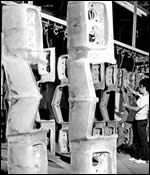No. 7 - Sheet Molding Compound
Bayer AG in Germany was the first to develop a process to produce thermoset polyester sheet molding compound (SMC) during the early 1960s, while Owens Corning Fiberglas was instrumental in bringing the process to the U.S.
Bayer AG in Germany was the first to develop a process to produce thermoset polyester sheet molding compound (SMC) during the early 1960s, while Owens Corning Fiberglas was instrumental in bringing the process to the U.S. SMC combined resin, filler, and chopped glass in a doughy, easily handled sheet. The emergence of SMC resulted in the first mass-production process for composites, which offered a wide range of advantages over open-mold hand lay-up and spray-up composite methods.
A key discovery in the U.S. that aided the commercialization of SMC was Uniroyal’s patented technology from the early 1950s on the use of magnesium oxide for chemical thickening. That enabled producing a semi-solid rather than runny mix of resin, filler, and chopped glass.
Another key discovery was thermoplastic low-profile/low-shrink additives, which were crucial to SMC’s future in exterior automotive body panels, where the painted surface finish had to match that of steel. Rohm and Haas launched low-profile SMC in the mid-’60s with its P19 acrylic system. That was followed by Union Carbide’s modified polyvinyl alcohol additive.
Owens Corning established a lab in Granville, Ohio, to focus on development of an SMC production process. In the mid-1960s, OCF researcher Everett Miller made the first SMC manufacturing machine in the U.S. Future commercial machines were based on that prototype and Miller’s later innovation of a dual wire-mesh belt compaction system that was highly efficient in impregnating random chopped glass. Miller’s machine had a novel wide fiberglass cutter, unlike European systems, which used prefabricated glass mat.
In the early days, another key player was Marco Chemical of Linden, N.J., (later acquired by W.R. Grace) which purchased the polyester resin business and patent from Uniroyal.
In the late 1960s, several companies began to produce SMC material and compression mold parts. Among them were Budd Plastics (now ThyssenKrupp Budd), Premix Inc., Rockwell International, Eagle-Picher (now Meridian), and GenCorp. (now also Meridian). A key early supplier of SMC impregnating lines was Finn & Fram in San Bernadino, Calif.
The auto industry took a strong liking to SMC and it became the predominant market for the material. The first SMC automotive part commercialized in North America is generally considered to be the rear air deflector on Chrysler station wagons in 1969, although there is dispute involving another part. In the same year, the International Harvester (now Navistar) truck hood was the first heavy-truck composite part converted from preform molding to SMC.
Another early application was the one-piece grille opening panel (GOP), which debuted on the Pontiac Tempest in 1970, highlighting SMC’s ability to consolidate a number of formerly separate metal parts.
In 1972, body panels on GM’s Chevrolet Corvette were converted from liquid molding to SMC. More penetration in exterior body panels (hoods, doors, tailgates) came with the Pontiac Fiero in 1984 and GM’s APV van in 1990, both SMC-intensive vehicles. In 1992, the first high-volume structural application for SMC was the cross-car beam for the Ford Ranger pickup and Explorer SUV.
SMC’s ability to produce complex shapes gave rise to electrical and business-equipment parts such as Xerox copier frame components. Other non-automotive applications include shower stalls, bathware, and fire helmets.
SMC today is looking to deliver even more weight reduction and the trend is toward more structural automotive applications like truck boxes, mid-gates, and seat backs.
Read Next
Understanding Melting in Single-Screw Extruders
You can better visualize the melting process by “flipping” the observation point so that the barrel appears to be turning clockwise around a stationary screw.
Read MorePeople 4.0 – How to Get Buy-In from Your Staff for Industry 4.0 Systems
Implementing a production monitoring system as the foundation of a ‘smart factory’ is about integrating people with new technology as much as it is about integrating machines and computers. Here are tips from a company that has gone through the process.
Read More









.png;maxWidth=300;quality=90)



(1).png;maxWidth=300;quality=90)







